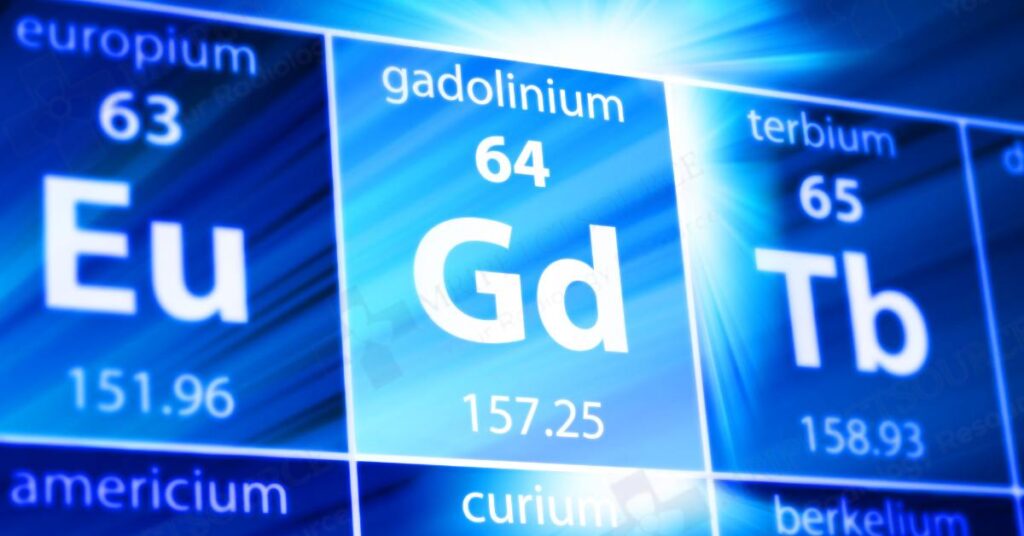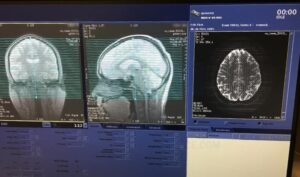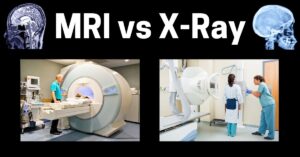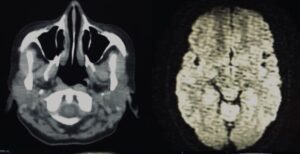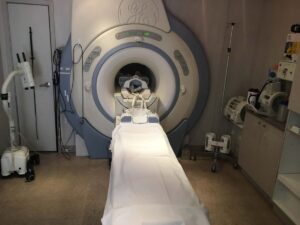Gadolinium, a magnetic marvel, revolutionizes the clarity and precision of MRI scans. Join us on a journey through the intricate world of materials science to discover how gadolinium, with its distinctive properties, evolved into an invaluable ally in the pursuit of advanced medical diagnostics.
What is Gadolinium?
Gadolinium is a silver-white, malleable, and ductile metal that tarnishes slowly in dry air and reacts slowly with water. Gd is a member of the lanthanide series on the periodic table with a proton number of 64. The lanthanide group of elements is known for their unique electron configurations and magnetic properties.
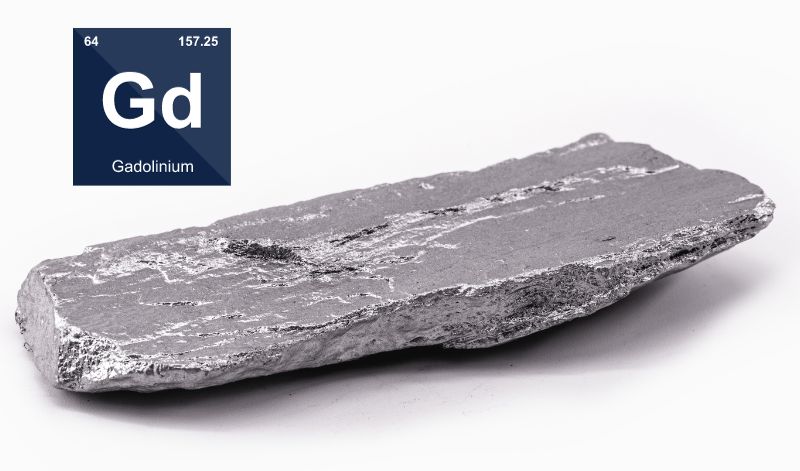
Swiss chemist Jean Charles Galissard de Marignac discovered gadolinium through his systematic investigations into the composition of the mineral gadolinite. In 1880, he successfully isolated gadolinium oxide from the mineral, marking the first recognition of the element.
However, the element gadolinium is named after Johan Gadolin, a Finnish chemist and geologist, in recognition of his significant contributions to the field.
On the periodic table, gadolinium belongs to the lanthanide series, also known as the rare earth elements. It shares characteristics with other lanthanides but is unique due to its curie point being near room temperature. This makes it an ideal material for medical imaging applications.
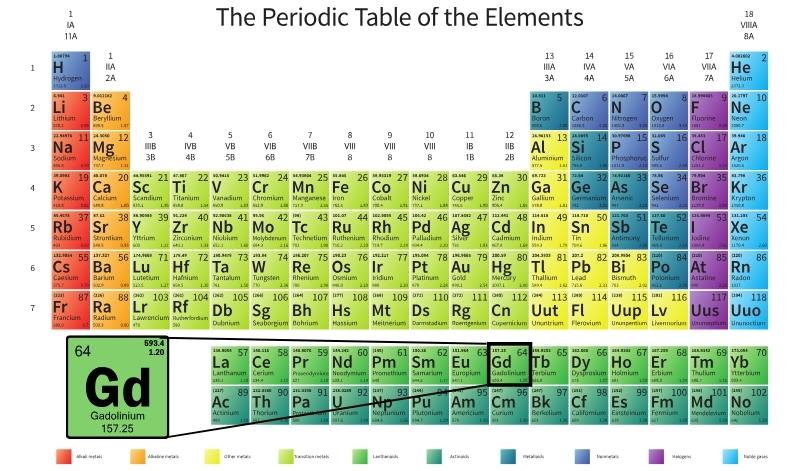
How is Gadolinium Produced?
Complex processes extract Gadolinium from minerals such as gadolinite, bastnaesite, monazite, and other rare earth metals. Refinement involves various steps, including solvent extraction and ion exchange, due to the intricate nature of rare earth elements. Gd can also be extracted by reducing anhydrous gadolinium fluoride with calcium metal.
Magnetic Properties of Gadolinium
One of the most intriguing aspects of gadolinium lies in its magnetic properties. Gd is unique among the lanthanides because it possesses a high magnetic moment, resulting from its outer 4f electron configuration.
Gadolinium is an ideal metal for medical imaging applications because of its ability to undergo a magnetic phase transition near room temperature.
Gadolinium undergoes a fascinating transition in its magnetic behavior around its Curie point, approximately 17 degrees Celsius (63 degrees Fahrenheit). Above this critical temperature, gadolinium exists in a paramagnetic state, responding to strong external magnetic fields by becoming temporarily magnetized.
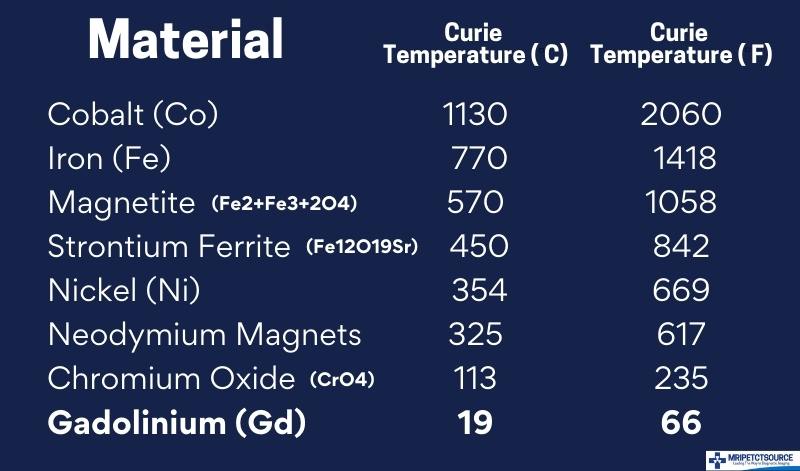
However, below the Curie point, gadolinium shifts to a ferromagnetic state, where its magnetic moments align in a parallel fashion, creating a more sustained magnetic effect.
This behavior is particularly advantageous in the field of medical imaging, as it allows gadolinium-based contrast agents to enhance the visibility of certain tissues during MRI scans.
The temperature-sensitive shift between paramagnetic and ferromagnetic states enables gadolinium to dynamically serve as a contrast agent, allowing it to target specific regions of the anatomy. When injected into the patient’s bloodstream, gadolinium based contrast agents (GBCAs) temporarily alter the magnetic properties of surrounding tissues, making them more visible in the MRI images.
How Do Gadolinium Based Contrast Agents Work?
The use of gadolinium-based MRI contrast agents have revolutionized the way healthcare professionals diagnose and monitor diseases. MRI relies on the interaction between the magnetic properties of hydrogen nuclei in the body’s tissues and the powerful magnetic field generated by the MRI machine.
Gadolinium-based contrast agents work by altering the relaxation times of nearby hydrogen nuclei, within the anatomy. In other words, GBCA’s alter the magnetic properties of surrounding tissue to enhance visibility in MRI images. The presence of Gd influences T1 (longitudinal) and T2 (transverse) relaxation times, thereby enhancing image contrast. This property is particularly valuable in highlighting specific structures or abnormalities that may not be clearly visible in standard MRI scans.
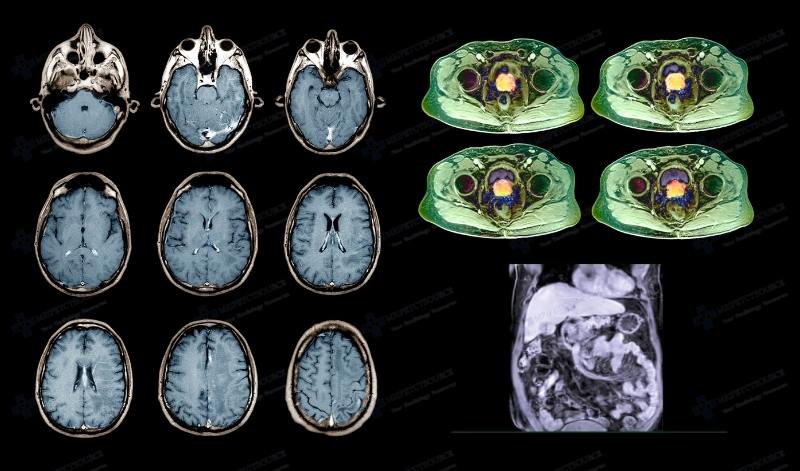
Gadolinium-based contrast agents play a crucial role in enhancing the contrast of MRI images. These contrast agents contain chelated gadolinium ions, where Gd molecules are bound to a chelating agent. This ensures the safe administration of a stable contrast agent with a low risk of toxicity.
Several factors contribute to gadolinium’s suitability as an ideal material for MRI contrast agents:
High Magnetic Moment and Paramagnetic Properties
Gadolinium’s high magnetic moment makes it an excellent candidate for enhancing contrast in MRI images. Its unique magnetic properties, including the ability to transition between ferromagnetic and paramagnetic states, contribute to its effectiveness in altering tissue relaxation times.
Gadolinium is a paramagnetic element, meaning it becomes partially magnetized when exposed to a strong external magnetic field. This property is essential for creating contrast in MRI images by temporarily modifying the magnetic environment around tissues.
Selective Tissue Targeting
GBCAs are designed to selectively target specific tissues or pathological conditions. This targeted approach allows for more precise imaging and diagnosis.
Biocompatibility
Gadolinium-based contrast agents have demonstrated a high degree of biocompatibility, minimizing adverse reactions in patients. This, coupled with their low toxicity, enhances the safety profile of these agents.
The chelation of gadolinium with specific ligands ensures molecular stability and prevents the release of free gadolinium ions in the body, reducing the risk of toxicity. This stability is crucial for the safe administration of gadolinium-based contrast agents.
Despite its numerous advantages, it is important to note that concerns about the potential retention of gadolinium in the body, especially in patients with impaired renal function, have been raised. Ongoing research aims to address these concerns and improve the safety profile of GBCAs.
Conclusion
In the world of materials science and medical imaging, gadolinium stands out as a magnetic marvel. Gadolinium’s unique magnetic properties, coupled with material science advancements, make it an indispensable element in developing MRI contrast agents. Researchers anticipate ongoing studies to drive further innovations and refinements in gadolinium-based contrast agents, ensuring a continuous improvement in medical imaging.
Recommended Read: MRI Health Risks (Separating Fact From Fiction)
Related resources
- MRI Patient Resources Library
- MRI Questions and Answers Wiki
- MRI Technologist Resources
- Radiology Blog
- MRIPETCTSOURCE YouTube Channel
Join the Medical Imaging Source Community!
Subscribe To Our Newsletter To Stay Up To Date With The Latest News, Exclusive Offers, And Giveaways!
The information provided by MRIPETCTSOURCE (“we,” “us,” or “our”) on https://www.medicalimagingsource.com (the “Site”) is for general informational purposes only. All information on the Site is provided in good faith, however we make no representation or warranty of any kind, express or implied, regarding the accuracy, adequacy, validity, reliability, availability, or completeness of any information on the Site. UNDER NO CIRCUMSTANCE SHALL WE HAVE ANY LABILITY TO YOU FOR ANY LOSS OR DAMAGE OF ANY KIND INCURRED AS A RESULT OF THE USE OF THE SITE OR RELIANCE ON ANY INFORMATION PROVIDED ON THE SITE. YOUR USE OF THE SITE AND YOUR RELIANCE ON ANY INFORMATION ON THE SITE IS SOLELY AT YOUR OWN RISK.

